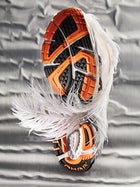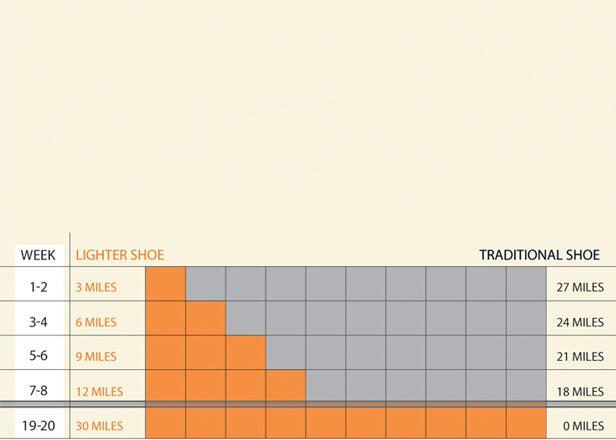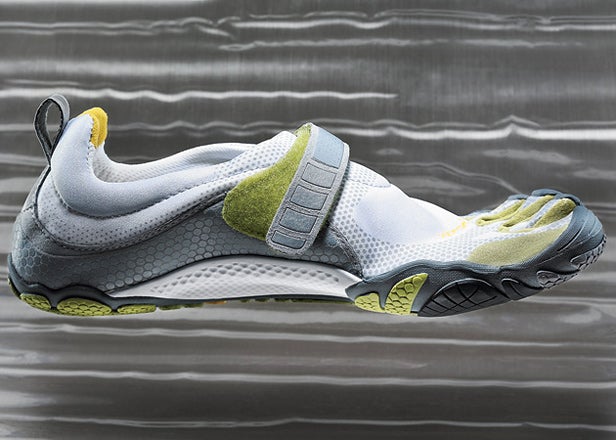Back to Basics
IF IT SEEMS LIKE there are a lot more dudes chugging down the trail or sidewalk in those foot-glove thingies these days, well, it’s because there are. Ever since the 2009 publication of Christopher McDougall’s bestselling barefoot-running manifesto, Born to Run, which profiles the sandal-wearing runners of Mexico’s Tarahumara tribe, the long-simmering barefoot (and nearly barefoot) running movement has exploded. This past year, Vibram sold $50 million worth of its barefootlike FiveFingers “shoes,” a five-fold increase from 2009, and this spring nearly every major running-shoe company has a barefoot-inspired line coming to market. While these models account for just a sliver of the $2.4 billion running-shoe market, some retailers estimate that minimalist models could make up a quarter of all performance running shoes sold next year, and the once-groundbreaking notion that less shoe is better is driving the change.
“Without a question, it’s the biggest revolution we’ve ever experienced,” says Curt Munson, owner of Michigan-based Playmakers, one of the country’s top running retailers. “The whole running industry is evolving.” This is a good thing. New research suggests that by helping you mimic the way a barefoot runner stridesÔÇöthat is, gently landing on your forefoot or midfootÔÇöminimally padded shoes can make you faster and more efficient, improve your form, and theoretically reduce injuries. But there’s one big caveat: a sudden switch from thickly to barely padded shoes is a terrible idea. What’s gone missing in the rush to run like our ancestors is the fact that our modern lifestyles have left our feet pampered and ill-prepared to go bounding down the trail in sandal-like shoes. Any transition has to be gradual, careful, and calculated.
One reason you can’t change your shoes and your stride overnight is that we’ve become a nation of heel strikers. The thickly cushioned shoes that helped usher in the running boom of the 1980s still dominate the market, accounting for the vast majority of all shoes sold. While they’re really comfortable and make jogging less painful for new and heavier runners, their built-up heel pads and steep ramp angles (the interior slope from the heel down to the toe) all but force you to land on your heel, an unnatural motion that increases the shock waves going up the leg (by as much as 50 percent, according to one study, compared with runners who don’t land on their heels).
“Shoes with higher heels encourage heel striking because your brain thinks it’s OK to land that way,” says Dr. Mark Cucuzzella, founder of Shepherdstown, West Virginia’s Two Rivers Treads, the country’s first store dedicated to minimalist running shoes. But it’s not OK. Between 37 and 60 percent of all runners suffer overuse injuries every year, a rate similar to that of the late 1980s, despite 20 years of advancements in shoe technology.
Don’t chuck your traditional training shoes out the window, though. There’s still no hard evidence that minimalist shoesÔÇöand the more natural stride they promoteÔÇöwill lower your risk of injury. And abruptly switching to featherweights, or even just models that are lower to the ground and less padded, will only increase the odds of injury. “If you transition too quickly, you’ll probably get hurt,” says biomechanist Iain Hunter, an associate professor of exercise science at Brigham Young University. Even so, if you’re like most runners, there’s a good chance you’re wearing more shoe than you needÔÇöand easing into a more sparsely padded one will almost certainly help improve your form and make you a faster, more efficient runner.
A Primer on Barefoot Running Shoes
Running in minimalist shoes can make you stronger and faster, but it also involves changing your gait. Here's how to get started.
ASICS's 10-ounce Gel-DS Trainer 16
 ASICS's 10-ounce Gel-DS Trainer 16
ASICS's 10-ounce Gel-DS Trainer 16Pick the Right Shoe
Go to a specialty running store (find one at ) and ask the salesperson to point you to a shoe that’s a bit lighter, less cushioned, and built with a slightly lower heel than your current one. Don’t make any drastic changes. Dropping cushioning too rapidly can, for example, leave you with a stress fracture, and switching to a shoe with a dramatically lower heel puts extra strain on your Achilles. Here’s a good, gradual progression:
GET YOUR FEET WET
To begin easing into lighter shoes, look for a traditional running shoe that’s been put on a diet, like ASICS‘s 10-ounce Gel-DS Trainer 16 (left; $110;
). The heel is a bit lower to the ground than a traditional shoe’s, and there’s a little less forward slope to the insole, so it won’t come as a huge shock to your feet.
HIT A NEW STRIDE
Once you’re accustomed to sparer shoes, it’s easier to transition into midfoot running. Besides being even lighter and closer to the ground than the ASICS, New Balance‘s 8.2-ounce Minimus MR10 (see page 85; $100;
) has a relatively flat midsole, which helps to discourage heel striking.
GO (NEARLY) BARE
Strong, well-conditioned feet need very little shoe at all (witness Abebe Bikila, who won the 1960 Olympic marathon barefoot). Vibram‘s six-ounce FiveFingers Bikila (see above right; $100;
) has just a hint of padding and an almost completely flat midsole, so landing softly on your midfoot is just about mandatory.
Easy Does It
You need to adjust to your new shoes very gradually to avoid straining your muscles, tendons, and joints. The first week, run a mile in them every other day, using your original shoes on all other runs. For the next two weeks, run about 10 percent of your mileage in your new shoes. Bump it up to 20 percent for the next two weeks, and so on (see “Make the Switch,” right). Repeat until you have no problems running all of your mileage in the new shoes, then repeat with another, slightly lighter, lower-to-the-ground pair.
Check Your Form
Running barefoot or with barefoot-style shoes means changing your gait to avoid injury.
barefoot running form
 Strike the ground near the ball of your foot or your mid-foot (not your heel).
Strike the ground near the ball of your foot or your mid-foot (not your heel).With less-padded shoes, you’ll need to run more softly. That means striking the ground near the ball of your foot or your midfoot (not your heel). Feel awkward? Try leaning slightly forward, taking quicker strides (about 180 steps per minute or more is ideal), and swinging your arms faster. “Don’t force change to happen,” Cucuzzella says. “Get your form down first, then add distance, and the speed will come later.”
1.
Striking the ground with your heel out in front of your body is both inefficientÔÇösince each footfall is like hitting the brakesÔÇöand hard on your legs, resulting in much higher impact forces on the heels, knees, hips, back, etc.
2.
Landing on your midfoot puts less impact on your body, since bent joints are natural shock absorbers. Hit the ground almost directly beneath your body, lean slightly forward, and use shorter, faster stepsÔÇöabout three per second.
Barefoot Running Training Plan

Use this training planÔÇöbased on a 30-mile-per-week training loadÔÇöto transition slowly from your old shoes to your new minimalist kicks.


